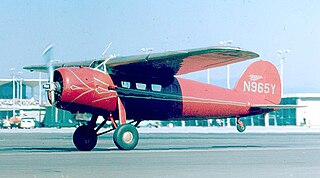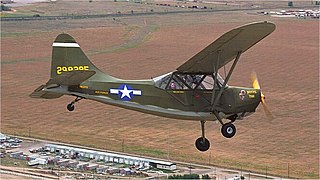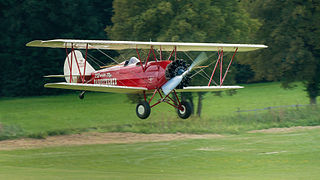
The Lockheed Vega is an American five- to seven-seat high-wing monoplane airliner built by the Lockheed Corporation starting in 1927. It became famous for its use by a number of record-breaking pilots who were attracted to its high speed and long range. Amelia Earhart became the first woman to fly solo across the Atlantic Ocean in one, and Wiley Post used his to prove the existence of the jet stream after flying around the world twice.

The Avro 504 was a First World War biplane aircraft made by the Avro aircraft company and under licence by others. Production during the war totalled 8,970 and continued for almost 20 years, making it the most-produced aircraft of any kind that served in any military capacity during the First World War. More than 10,000 were built from 1913 until production ended in 1932.

The Fairchild PT-19 is an American monoplane primary trainer aircraft that served with the United States Army Air Forces, RAF and RCAF during World War II. Designed by Fairchild Aircraft, it was a contemporary of the Kaydet biplane trainer, and was used by the USAAF during Primary Flying Training. As with other USAAF trainers of the period, the PT-19 had multiple designations based on the powerplant installed.

The Beechcraft Model 17 Staggerwing is an American biplane with an atypical negative wing stagger. It first flew in 1932.

The Pratt & Whitney R-985 Wasp Junior is a series of nine-cylinder, air-cooled, radial aircraft engines built by the Pratt & Whitney Aircraft Company from the 1930s to the 1950s. These engines have a displacement of 985 in3 (16 L); initial versions produced 300 hp (220 kW), while the most widely used versions produce 450 hp (340 kW).

The Howard DGA-15 was a single-engine civil aircraft produced in the United States by the Howard Aircraft Corporation from 1939 to 1944. After the United States' entry into World War II, it was built in large numbers for the United States Navy and also served various roles in the United States Army Air Forces.

The Stinson Reliant is a popular single-engine four- to five-seat high-wing monoplane manufactured by the Stinson Aircraft Division of the Aviation Manufacturing Corporation of Wayne, Michigan.

The Monocoupe 90 was a two-seat, light cabin airplane built by Donald A. Luscombe for Monocoupe Aircraft. The first Monocoupe was built in an abandoned church in Davenport, Iowa, and first flew on April 1, 1927. Various models were in production until the late 1940s.

The Cessna Airmaster, is a family of single-engined aircraft manufactured by the Cessna Aircraft Company. The Airmaster played an important role in the revitalization of Cessna in the 1930s after the crash of the aviation industry during the Great Depression.

The Stinson L-5 Sentinel is a World War II-era liaison aircraft used by the United States Army Air Forces (USAAF), U.S. Army Ground Forces, U.S. Marine Corps and the British Royal Air Force. It was produced by the Stinson Division of the Vultee Aircraft Company. Along with the Stinson L-1 Vigilant, the L-5 was the only other USAAF liaison aircraft that was exclusively built for military use and had no civilian counterpart.

The Scottish Aviation Pioneer was an STOL aircraft manufactured by Scottish Aviation in Scotland. It was used for casualty evacuation and communications and could accommodate a pilot and up to four passengers.

The Spartan Aircraft Company was an American aircraft manufacturing company, headquartered on Sheridan Avenue near the Tulsa Municipal Airport in Tulsa, Oklahoma. Previously known as Mid-Continent Aircraft Company, the company had been reorganized under the Spartan name in 1928 by oil baron William G. Skelly—and operated until 1961, manufacturing aircraft, aircraft components, and recreational vehicle trailers. The company was known for the luxurious Spartan Executive aircraft produced in the late 1930s and early 1940s.

The Consolidated Model 2 was a training airplane used by the United States Army Air Corps, under the designation PT-3 and the United States Navy under the designation NY-1.

The Harlow PJC-2 was a 1930s American four-seat cabin monoplane, designed by Max Harlow.

The Travel Air 2000/3000/4000 were open-cockpit biplane aircraft produced in the United States in the late 1920s by the Travel Air Manufacturing Company. During the period from 1924–1929, Travel Air produced more aircraft than any other American manufacturer, including over 1,000 biplanes. While an exact number is almost impossible to ascertain due to the number of conversions and rebuilds, some estimates for Travel Air as a whole range from 1,200 to nearly 2,000 aircraft.

The Saro Cloud was a British passenger amphibian flying boat designed and built by Saunders-Roe as the A.19. It was later produced as the A.29 for the Royal Air Force for pilot and navigator training.

The Spartan 12W Executive was a tricycle gear post-war development of the Spartan 7W Executive, produced by the Spartan Aircraft Company. The 12W was intended to have higher performance and be more economical than the 7W.

The Spartan C2 is a light aircraft produced in the United States in the early 1930s as a low-cost sport machine that would sell during the Great Depression.

The Spartan 8W Zeus was a prototype military aircraft trainer built by Spartan Aircraft Company in the United States in 1937. It was based on the airframe of the Spartan Executive civil aircraft. The sole airframe produced was designated serial number 8W-1 and was registered as NX17612

























